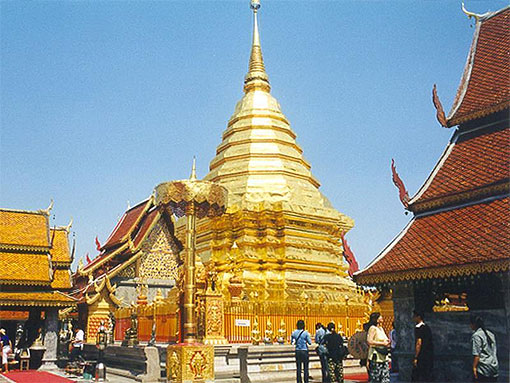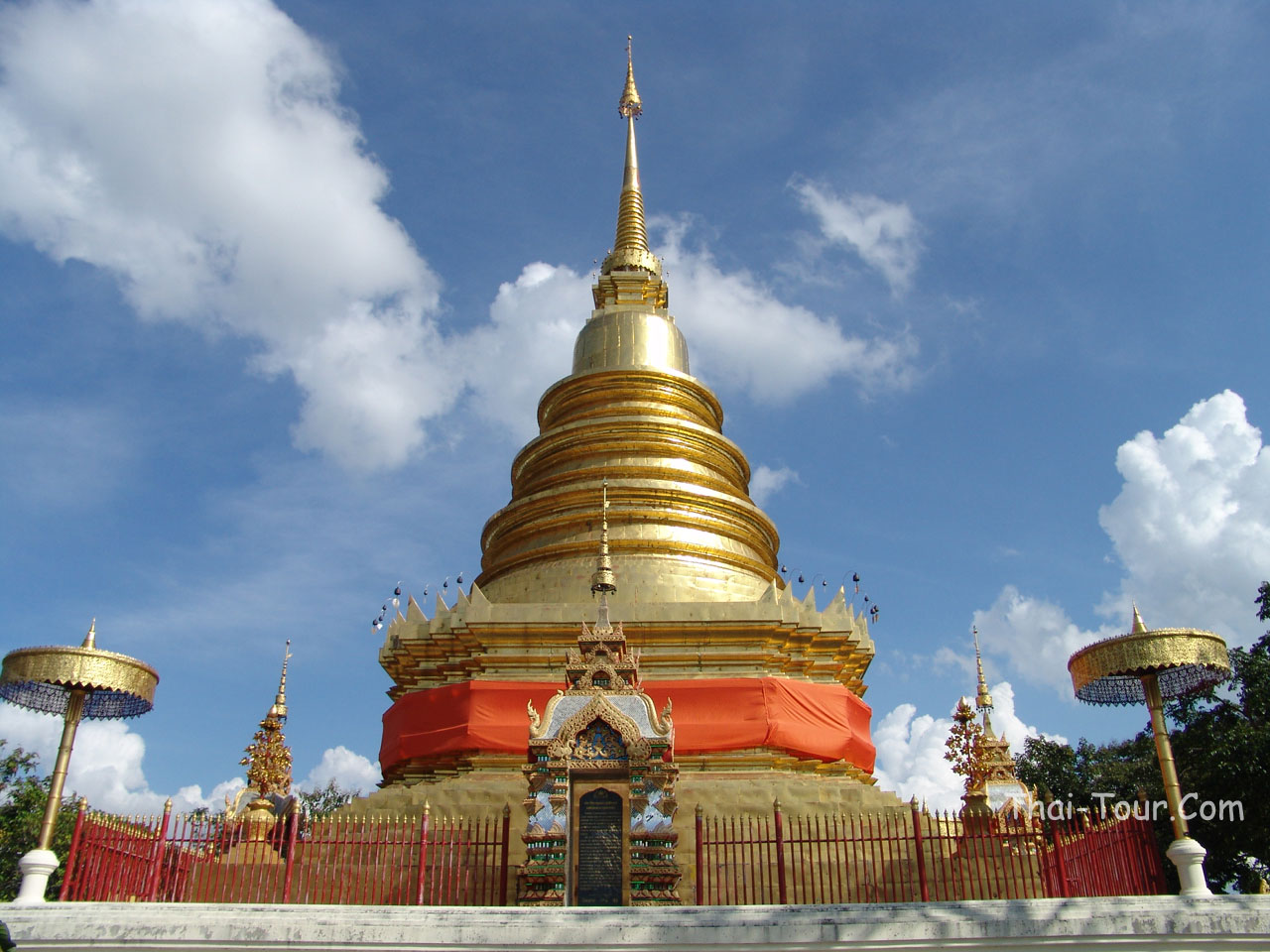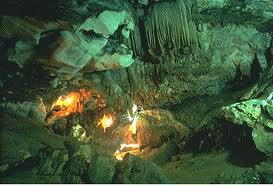Out-Of-City Attractions
Out-Of-City Attractions
West (Highway 1004)
Huai Kaeo Arboretum
Beside Chiang Mai University, this attractively landscaped
garden contains many kinds of tropical trees and flowers.
Chiang Mai Zoo
Next to Huai Kaeo Arboretum, this is a large and extremely
well-managed zoo occupying the lower forested slopes of Doi
Suthep mountain and showcasing more than 200 species of
Asian and African mammals and birds, as well as some adorable
pandas named Thewa and Thewi. Open daily from .00 a.m. to
.00 p.m. Restaurants and a camping site are available.
Tel. 0 5322 11 , 0 5335 11
Website: www.zoothailand.org/chiangmai
Namtok Huai Kaeo
Close by the zoo, this 10-metre cascade provides a green and
scenic picnic spot.
Wat Phrathat Doi Suthep
Situated 15 km. from town, this is Chiang Mai’s most famous
and most visible landmark, and at 3,520 feet above sea level,
it commands an exhilarating view of the city and surrounding
countryside. Dating from 13 3, the temple is approached by
a flight of 290 Naga-flanked steps (although the less energetic
may ascend by a funicular railway), and is dominated by
a golden Chedi which contains holy Buddha relics and attracts
Buddhist pilgrims from all over the world.
Phu Phing Palace
Further up the road from the foot of Wat Phrathat Doi Suthep,
the Phu Phing Palace is the Royal winter residence, built in
1 1. The lavishly landscaped gardens and grounds are open
to the general public daily from .30 a.m. to 4.30 p.m. except
when the Royal Family is in residence.
Doi Pui Tribal Village
This Hmong village lies some 3 km. from Phu Phing Palace.
It is the most accessible of hilltribe villages and has accordingly
lost some of its authenticity, although it still provides a glimpse
of tribal life.
Khruba Siwichai Monument
Situated at the foot of Doi Suthep Mountain, the monument
honours the devoted Buddhist monk whose followers built the
first 10- km. paved road to Wat Phrathat Doi Suthep in 1935.
Southwest (Highway 108)
Old Chiang Mai Cultural Centre
Located at the beginning of Chiang Mai-Hang Dong road
(Highway 10 ), the Centre has an excellent collection of Lanna
Thai art. It is also the venue for folk dance performances and
typical northern-style khan tok dinners. Open from 7 .00 a.m. to
9.30 p.m.
Tel. 0 532 4540, 0 532 50 , 0 5320 2 3-5
Website: www.oldchiangmai.com
Wat Phrathat Si Chom Thong
Located 5 km. from town, this intriguing temple dates from the
mid-1400s and houses a collection of bronze Buddha images
while a holy Buddha relic is enshrined in the secondary chapel.
Wat Phrathat Doi Noi
The temple, between KM 43 and 44, was built by the Mon
Queen Chamma Thewi in 5 AD. The hilltop location, reached
by a flight of 241 steps, affords fine views of the Ping River and
surrounding countryside.
Namtok Mae Klang
Chiang Mai’s most photographed waterfall lies some 5 km.
from town at the foot of Doi Inthanon. The picturesque setting
is a popular pinic spot.
Tham Borichinda
A 10-minute drive and a 2-hour walk from Mae Klang, this
large cave has stalactite and stalagmite formations, Buddha
images and a rocky stream.
Doi Inthanon National Park
The 1,005-sq. km. park encompasses Thailand’s highest peak
which rises to 2,565 metres above sea level. Rich in flora and
fauna, especially bird life, and with waterfalls, nature trails and
Hmong and Karen hilltribe villages, the park as a whole is one
of Chiang Mai’s top attractions and well worth visiting.
Doi Inthanon Royal Project Research Station
Located in Khum Klang village, close to the park headquarters,
this royally initiated research station was established in
1 to help hilltribe farmers to cultivate temperate-clime cash
crops instead of opium and to train them in modern agricultural
practices. The flower plantation and the plant and breeding
research lab are open to visitors.
Phra MahaThat Napha Methanidon
and Phra MahaThat Naphaphon Phumisiri
These twin pagodas, located at KM 41.5, were built to
commemorate the fifth cycle birthdays of Their Majesties King
Bhumibol Adulyadej and Queen Sirikit.
Traditional Cotton Weaving Village
Located 3 km. from Mae Chaem District Office in Tambon Tha
Pha, the village is famous for producing northern-style cotton
sarongs.
Op Luang Gorge
This picturesque gorge with a river zigzagging between high,
steep cliffs, is located 105 km. from Chiang Mai. The area is
pleasantly framed by teak forests and hills.
Ban Rai Phai Ngam
Also renowed for its high quality traditional cotton, this village
is reached after a left turn between Km. and 0 along the
Chiang Mai-Hot road.
Doi Tao Lake
Doi Tao district is 133 km. from Chiang Mai. The large reservoir
here lies behind Bhumibol Dam in Tak province and offers
recreational opportunities, including boat cruises.
Huai Phak Phai Royal Project
At Ban Mae Ha in Hang Dong district, this royally initiated
project is a research and cultivation centre for roses. The main
attraction is the .4-acre Royal Rose Garden, best seen between
October and February.
North (Highways 107 & 1096)
Tribal Museum
Situated in King Rama IX Lanna Garden on Chotana Road,
this ethnology museum has exhibits highlighting the separate
identities and cultures of the North’s nine major hilltribe groups,
Karen, Hmong, Yao, Lisu, Akha, Lahu Lau, Thin, and Khamu.
Open daily to the public from .00 a.m. to 4.00 p.m. except
Saturdays, Sundays and national holidays.
Tel. 0 5321 0 2
Orchid and Butterfly Farms
There are several orchid nurseries in the Mae Sa Valley area
where visitors can view these exotic year-round blooms. Some
orchid farms also have special butterfly enclosures where tropical species can be seen in a natural environment.
Mae Sa Snake Farm
Here, some 3 km. along the Mae Rim-Samoeng road, various
kinds of snakes indigenous to Thailand can be seen. There are
also daily 30-minute snake shows at 11.30 a.m., 2.15 p.m. and
3.15 p.m. Open from .00 a.m. to 4.00 p.m. Tel. 08 14 72 1566
Namtok Mae Sa
This -tiered waterfall in Mae Rim district is 2 km. from town
and occupies a lovely setting among towering trees.
Queen Sirikit Botanical Garden
This international botanical garden, located around 12 km.
along the Mae Rim-Samoeng road and extending over
a mountainous area of 5 0 acres, was established to honour
Queen Sirikit in 1 2. The garden has an excellent collection
of Thai and foreign plants laid out according to species and
climate, and there are three walking trails. Also here is
a Tourist Information Centre, the Thai Orchid Breeding Centre,
the herbs Museum and the Research Centre. Open daily from
.30 a.m. to 5.00 p.m.
Tel. 0 532 1 1-5 Ext. 2500, 0 532 53
Website: www.qsbg.org
Located off Highway 10 at KM 5 between Mae Taeng and
Chiang Dao, this is one of a number of elephant camps in the
area which put on shows of work elephants displaying their
forestry skills. Open from .00 a.m. to 3.00 p.m. daily. There are
shows starting at .00 a.m. and 10.00 a.m.
Tel. 0 5329 8553, 0 5386 203 7
Tham Chiang Dao
Sacred Buddha images can be seen in the cave complex of Wat
Chiang Dao at KM 2 on Highway 10 . The caves are illuminated by electric lights.
Doi Luang Chiang Dao
This cone-shaped limestone mountain in the Chiang Dao
Wildlife Reserve rises to 2,1 5 metres above sea level, which makes
it Thailand’s third highest peak after Doi Inthanon and Doi Pha
Hom Pok. The area is rich in highland flowers, birds, and butterflies.
Permission to visit the mountain must be obtained from
the National Park, Wildlife and Plant Conservation Department.
Tel. 0 256 2 076 0
Website: www.dnp.go.th
Huai Nam Dang National Park
The park, accessed via the Mae Malai-Pai road, covers an area
of 1 0 sq. km. in the Mae Taeng and Pai districts of Chiang Mai
and Mae Hong Son provinces. Forested highland ranges and
panoramic views are among the attractions.
Doi Ang Khang
This is the location of a Royal agricultural station, 1 3 km.
north of Chiang Mai, which is a demonstration site for the
research and cultivation of flowering plants, temperate fruit trees,
vegetables and other crops under the patronage of His Majesty
King Bhumibol Adulyadej. Outside the agricultural station, the
area of Doi Ang Khang is a nature resort where activities include
trekking, mule-riding and mountain-biking can be found.
Fang Hot Springs
Located at Ban Pin, km. northwest of Fang town, 50 hot
springs occupy a 10-acre forest setting. Three of them boil continuously with water temperatures of 0 to 100 degrees Celsius.
Ban Tha Ton
Sited on the banks of the Kok River, close to the border with
Myanmar, this small town is full of atmosphere and has a few
interesting sights, such as Wat Tha Ton. However, it is best
known as the starting point for longtail boats trips downriver to
Chiang Rai, a thrilling 3 1/2 hour journey that passes hilltribe
villages and jungle scenery. It is also possible to hire bamboo
rafts for the same trip, the journey taking 3 days.
East (Highways 118 & 1006)
San Kamphaeng
This district, 13 km., is famous for its silk and cotton weaving.
The village showcases finished products as well as the
silk- weaving process. On the way from Chiang Mai to San
Kamphaeng, the road is lined with factories and souvenir shops
selling woodcarving, silverware, earthenware, lacquerware, and
cotton fabrics.
San Kamphaeng Hot Springs
Located 3 km. from town and set amid natural surroundings
of trees and verdant hills, these springs have water with a high
sulphur content and possess curative and restorative properties.
Accommodation, a swimming pool, dining facilities and
segregated mineral water bathing rooms are available. Nearby is
Rung Arun Hot Sping Resort which offers bungalows, mineral
baths and an excellent park setting.
Subscribe to:
Posts (Atom)






















No comments:
Post a Comment